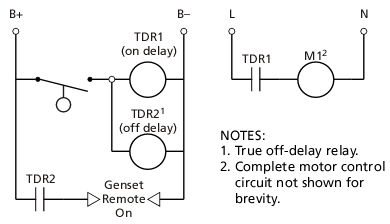Scott K
Member
- Location
- Boynton Beach, FL USA
I am trying to design a control circuit to start a generator to power an irrigation pump in the following sequence.
1. start generator on water level drop. allow generator to run 3-4 mins to warm up.
2. start irrigation pump.
3. stop pump on water level rise.
4. allow generator to run 3-4 mins to cool down then shut off.
5. reset for next sequence.
The irrigation pump is existing and has a magnetic starter with a 120 volt coil controlled by an existing float switch to maintain water level.
The start circuit for the generator is 12v DC.
I think this can be done with a couple of time delay relays. I have a "True off" TD relay with 12v input to stop the generator and a "on delay" TD relay with 120v input to start the pump. Am I on the right track?
Any advice or suggestions would be greatly appreciated.
Thanks in advance!
1. start generator on water level drop. allow generator to run 3-4 mins to warm up.
2. start irrigation pump.
3. stop pump on water level rise.
4. allow generator to run 3-4 mins to cool down then shut off.
5. reset for next sequence.
The irrigation pump is existing and has a magnetic starter with a 120 volt coil controlled by an existing float switch to maintain water level.
The start circuit for the generator is 12v DC.
I think this can be done with a couple of time delay relays. I have a "True off" TD relay with 12v input to stop the generator and a "on delay" TD relay with 120v input to start the pump. Am I on the right track?
Any advice or suggestions would be greatly appreciated.
Thanks in advance!


